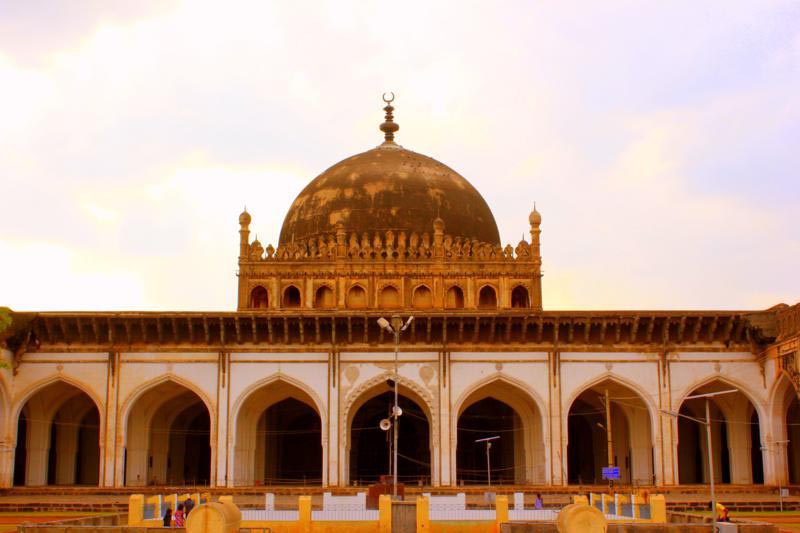Mehtar Mahal

Information on Mehtar Mahal (Bijapur, Karnataka) - History & Architecture
Mehtar Mahal is located in the Bijapur fort in the district of Bijapur in the state of Karnataka in South India. It dates back to 1620, though it is sized modestly, it is one of the significant structures in this particular fort. In Indo-Saracenic style and pattern, the entry gate has been built. The domestic and foreign tourists visit the Bijapur Fort; they throng to visit the Mehtar Mahal because of its historical and architectural significance. It is an unique structure that standout among other magnificent structures within and outside the Fort premises.
Mehtar Mahal Architecture
In the Bijapur Fort, Mehtar Mahal is one of the most elegant and attractive structure. This particular building structure has shades of Indo-Saracenic and Hindu traditional architectural style with a lot of perfection. The fa�ade has arches which are three in numbers that displays exquisite cornice largely supported on carved corbels to a great extent. Mehtar mosque is near Mehtar Mahal which is a three-storey building structure. It has perfectly two slender minarets which are rightly covered with carved delicately rows of swans and birds. The said carvings are in architectural style of Hindu religion without the shades of Islamic architectural styles. The structure has minarets of rounded tops and flat roof.
Mehtar fort is within the Bijapur Fort which is strongly built with walls of varying heights of 50 to 15 feet. This fort belongs to the 16th century, built by Yusuf Adil Shah in 1566. The materials used in the making of this Fort and other important structures are granites and lime mortar. Mehtar Mahal is speciously roomed with good ventilation and better view of the happenings in the fort premises. The interior and exterior decoration of Mehtar Mahal makes really wonder in its unique beauty and attraction.
Mehtar Mahal History
In 1481, Yusuf Adil Shah, the Sultan of Turkey and eldest son of Murad II, had wholeheartedly joined the Bidar court under the then Sultan Mohammed III of the sultanate. Mahmud Gavan, the Prime Minister of the Kingdom had purchased actually him as slave. Later, he was appointed directly as Bijapur's Governor because of his bravery and loyalty shown in the strong active defense of the kingdom. The Faroukh Mahal, the fort and the citadel were built during his successful period with the assistance of skilled artisans and architects from Persia, Italy and Turkey.
In 1489, Yusuf in a successful manner established the Adil Shahi dynasty. It is to be highly noted that Bijapur Sultanate was one of the five kingdoms of this particular empire. Ibrahim Adil Shah, son of Yusuf Adil Shah succeeded his father in 1510. He built the Jami Masjid within the fort premises. Ali Adil Shah I succeeded Ibrahim Adil. He built the Chand Bawdi, Gagan Mahal, the Jami Masjid and Ali Rauza. He was succeeded by his nephew Ibrahim II. He was a secular King who built the Saraswati and Ganapathi temples within the fort complex.
Ali Adil Shah II who was the adopted son of the king came to power in 1646. The dynasty control later suddenly weakened. Shivaji who was a strong Maratha ruler attacked Bijapur several times. Finally, in the year 1686, Aurangzeb annexed the kingdom. Later in 1877, the fort fell in the hands of the British empire after the end of the Mughal rule.
Mehtar Mahal Tourism Importance
The domestic and foreign tourists who come the Fort of Bijapur can also visit Jamia masjid, Ibrahim Rauza, Mehtar Mahal, Malik-i-Maidan, Gagan Mahal, Sat Manzili, Asar Mahal, Taj Bawdi, Gol Gumbaz, Sangeet - Nari Mahal and Saath Khabar. It really needs a day's time to enjoy these attractive structures and its architectural beauty. Tourists really feel as if they are standing in the medieval period.
- Bangalore Monuments
- Bagalkot Monuments
- Belgaum Monuments
- Bellary Monuments
- Bidar Monuments
- Bijapur Monuments
- Chitradurga Monuments
- Coorg Monuments
- Dakshina Kannada Monuments
- Gadag Monuments
- Gulbarga Monuments
- Hassan Monuments
- Mysore Monuments
- Raichur Monuments
- Uttara Kannada Monuments
- Yadgir Monuments
- Andaman Nicobar Monuments
- Andhra Pradesh Monuments
- Assam Monuments
- Bihar Monuments
- Chhattisgarh Monuments
- New Delhi Monuments
- Goa Monuments
- Gujarat Monuments
- Haryana Monuments
- Himachal Pradesh Monuments
- Jammu and Kashmir Monuments
- Karnataka Monuments
- Kerala Monuments
- Madhya Pradesh Monuments
- Maharashtra Monuments
- Odisha Monuments
- Punjab Monuments
- Rajasthan Monuments
- Tamil Nadu Monuments
- Telangana Monuments
- Uttar Pradesh Monuments
- West Bengal Monuments